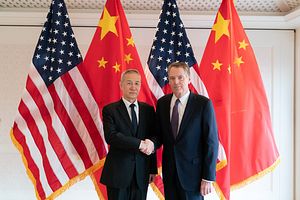The United States and China announced on December 13 that they have reached agreement on their “phase one” trade deal, a major development in the 20-month trade war. In exchange for tariff relief, China will increase its purchases of U.S. goods and address U.S. concerns relating to intellectual property (IP) protection, currency manipulation, and agriculture, among others.
“China and the United States have agreed on the text of a phase one economic and trade agreement based on the principle of equality and mutual respect,” Xinhua, China’s state run news agency, reported on Friday. “The text includes nine chapters: the preface, intellectual property rights, technology transfer, food and agricultural products, financial services, exchange rate and transparency, trade expansion, bilateral assessment and dispute settlement, and the final terms, according to a statement issued by the Chinese side Friday night.”
The full details of what, exactly, China agreed to change in these areas remain unclear.
According to a statement from the Office of the United States Trade Representative, the phase one deal “requires structural reforms and other changes to China’s economic and trade regime in the areas of intellectual property, technology transfer, agriculture, financial services, and currency and foreign exchange.”
“President Trump has focused on concluding a Phase One agreement that achieves meaningful, fully-enforceable structural changes and begins rebalancing the U.S.-China trade relationship,” said United States Trade Representative Robert Lighthizer. “This unprecedented agreement accomplishes those very significant goals and would not have been possible without the President’s strong leadership.”
That statement added, “Importantly, the agreement establishes a strong dispute resolution system that ensures prompt and effective implementation and enforcement.” The need for an enforcement mechanism has long been a crucial concern of US negotiators, given perceived lack of follow-through on previous promises from China. Here again, details on how, precisely, the dispute resolution system will work remain to be released.
For its part, China framed any concessions as “generally in line with the main direction of China’s deepening reform and opening up as well as the internal needs for advancing the high-quality economic development.”
Implementation of the agreement will help enhance intellectual property rights protection, improve the business environment, expand market access, better safeguard the legitimate rights and interests of all companies including foreign firms in China, and protect the legitimate rights and interests of Chinese firms in their economic and trade activities with the United States.
Xinhua also noted that the “The increase in imports is conducive to boosting the country’s consumption upgrading and meeting Chinese people’s growing needs for a better life.” Translation: the “substantial additional [Chinese] purchases of U.S. goods and services in the coming years” anticipated by the USTR statement are for China’s own benefit.
The Chinese media framing maintains the fiction that China was planning on these moves all along, rather than being pressured into them by the U.S. trade war.
China’s main concern in any trade deal was securing immediate tariff relief. That was not totally forthcoming. The USTR statement made a point of noting that “The United States will be maintaining 25 percent tariffs on approximately $250 billion of Chinese imports, along with 7.5 percent tariffs on approximately $120 billion of Chinese imports.” Trump did note in a tweet, however, that “The Penalty Tariffs set for December 15th will not be charged because of the fact that we made the deal.”
According to the Chinese summary released by Xinhua, the deal also includes a commitment for the United States to “to phase out its additional tariffs on Chinese products, so as to achieve a switch from hiking to cutting additional tariffs.” Importantly, no “phase out” of tariffs was mentioned in the U.S. announcement, hinting at a possible gap that could cause a relapse into tensions in 2020.
China’s own internal economic deliberations provide an interesting foil to the phase one trade deal statements.
Just ahead of the deal announcement, China concluded its annual Central Economic Work Conference (CEWC). Held from December 10 to 12, the CEWC “reviewed the country’s economic work in 2019, analyzed the current situation and outlined key tasks for 2020,” as Xinhua put it. The CEWC obliquely emphasized the need for economic reform, concluding that “we must see that China is at a pivotal stage of transforming its growth model, improving its economic structure, and fostering new drivers of growth.” However, its bottom line is that all economic growth – past and future – came because China has “upheld the centralized and unified leadership of the CPC [Communist Party of China] Central Committee, maintained strategic resolve, kept pursuing progress while ensuring stability, deepened reform and opening-up, and given full play to the enthusiasm of central and local governments” – in that order. “Reform and opening” (including the promises made in the phase one deal) thus falls behind tight Communist Party control, keeping a firm “resolve” (presumably in the face of external pressure), and maintaining stability on the list of priorities.
It’s little wonder, then, that the CEWC statement included a hint of pessimism, warning that “We need to be well prepared with contingency plans” in 2020.
There was no such caution on display from Trump, however. He’s already looking ahead to the next agreement, announcing on Twitter that “We will begin negotiations on the Phase Two Deal immediately, rather than waiting until after the 2020 Election.”
He concluded: “This is an amazing deal for all. Thank you!”

































